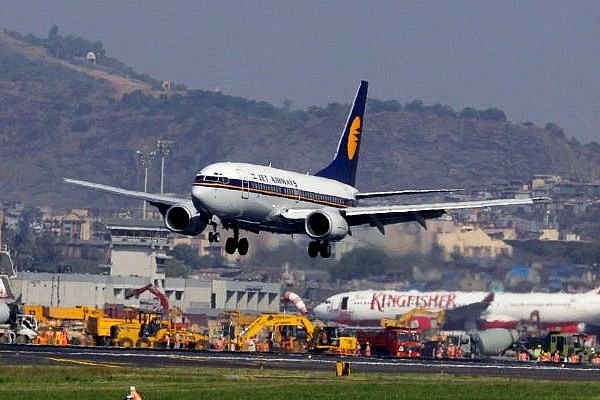Business
Why Jet Airways Second Quarter Results Are Indicative Of A Crunch In Domestic Aviation
- With global crude oil prices seeing a correction and India’s peak tourism season kicking in, can these factors be seen as a ray of hope for the domestic aviation sector?

A Jet Airways plane takes off in Mumbai. (Vijayananda Gupta/Hindustan Times via GettyImages)
The impact of global crude oil prices soaring past $80 a barrel in late September 2018 quarter and the inability of airlines to pass them on to passengers has clearly impacted the financial performance of leading players like Jet Airways. The airline reported a net loss of Rs 1,297.46 crore for the September 2018 quarter vis-a-vis a net profit of Rs 49.6 crore a year earlier, and that’s despite revenue from operations increasing 9.5 per cent year-on-year (y-o-y) to Rs 6,161.2 crore in the second quarter of the current fiscal.
That’s because the key operational cost for Jet Airways, aircraft fuel expenses, had jumped 58.6 per cent y-o-y to Rs 2,419.76 crore in the September 2018 quarter.
The problems for Jet Airways do not end there. The airline is also facing difficulties in financing day-to-day operations with the company’s current liabilities that far exceed its current assets at the end of the second quarter of current fiscal.
For instance, at the end of September 2018 quarter, the current assets (which include cash, bank balances and trade receivables) of Jet Airways were barely Rs 7,784.19 crore while its current liabilities amounted to Rs 15,997.45 crore. Current liabilities of the airline include borrowings and trade payables.
In a press release dated 31 October 2018 to the Bombay Stock Exchange, Jet Airways management had pointed out that the company is in receipt of notices for payment delays/defaults from few aircraft lessors.
To deal with a rather difficult financial situation, the airline’s board in late August 2018 had announced a cost reduction programme that would exceed Rs 2,000 crore over the next two years that would include optimising maintenance costs, selling and distribution costs.
In addition, the board had also highlighted capital infusion and debt reduction that would also help to bring down the company’s interest/finance costs. For instance, Jet Airways finance costs amounted to Rs 231.38 crore in the second quarter of the current fiscal, a rise of 22.2 per cent y-o-y. However, details related to the company’s fundraising programme are still sketchy currently.
The difficult operating environment for Jet Airways had not gone unnoticed by the credit ratings agencies, too. In early October 2018, ICRA had revised lower the long-term rating assigned to Jet Airways’ long-term loans and non-convertible debentures to B (negative outlook) from BB (negative outlook). The airline attributed the ratings downgrade to the steep increase in jet fuel prices and rupee depreciation as well as the delays in implementation of liquidity initiatives by the company.
Investors Are Nervous
Investors on Dalal Street have been worried with regard to stocks in the aviation sector. Jet Airways quarterly results were declared on Monday (12 November) after the close of trading, but the stock had already declined nearly 6 per cent to end at Rs 242.1. The stock has fallen sharply from its 52-week high of Rs 883.7 reached on 5 January 2018.
Earlier, rival InterGlobe Aviation, which operates IndiGo Airlines, reported a net loss of Rs 652.1 crore for the September 2018 quarter vis-a-vis a profit of Rs 551.5 crore a year earlier, and that’s despite revenue from operations increasing 16.9 per cent y-o-y to Rs 6,185.3 crore in the second quarter of the current fiscal. Investors have been nervous with this stock, too, and it had declined 4.3 per cent to close at Rs 948.5 on Monday. This stock has corrected significantly from its 52-week of Rs 1,520 reached on 20 April 2018.
The financial viability of the airline sector has been a key concern with investors, given the bankruptcy of the once popular Vijay Mallya-run Kingfisher Airline in mid-2012. At that time too, high global oil prices was one of the main reason for the collapse of the above airline.
A Ray Of Hope
Global crude oil prices have corrected nearly 15 per cent from the levels prevailing in early October and it should help the broader airline sector better manage their key operating costs. Also, the peak tourism season has commenced in the country and coupled with higher airfares during this season it should help airlines to improve their financial position over the next few quarters.
Support Swarajya's 50 Ground Reports Project & Sponsor A Story
Every general election Swarajya does a 50 ground reports project.
Aimed only at serious readers and those who appreciate the nuances of political undercurrents, the project provides a sense of India's electoral landscape. As you know, these reports are produced after considerable investment of travel, time and effort on the ground.
This time too we've kicked off the project in style and have covered over 30 constituencies already. If you're someone who appreciates such work and have enjoyed our coverage please consider sponsoring a ground report for just Rs 2999 to Rs 19,999 - it goes a long way in helping us produce more quality reportage.
You can also back this project by becoming a subscriber for as little as Rs 999 - so do click on this links and choose a plan that suits you and back us.
Click below to contribute.
Latest